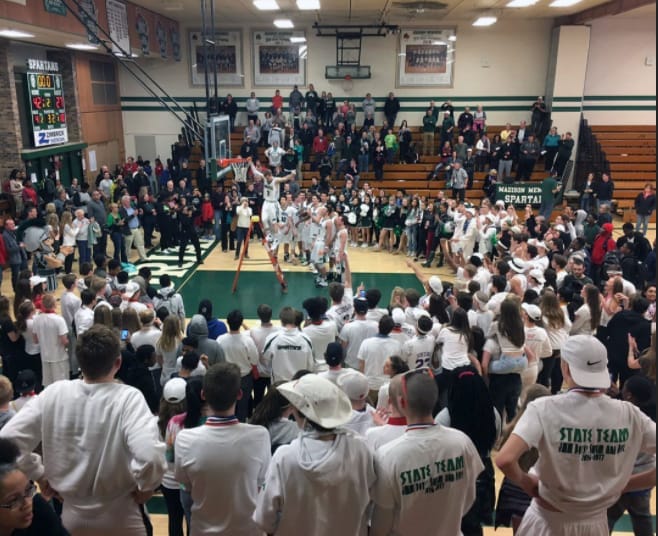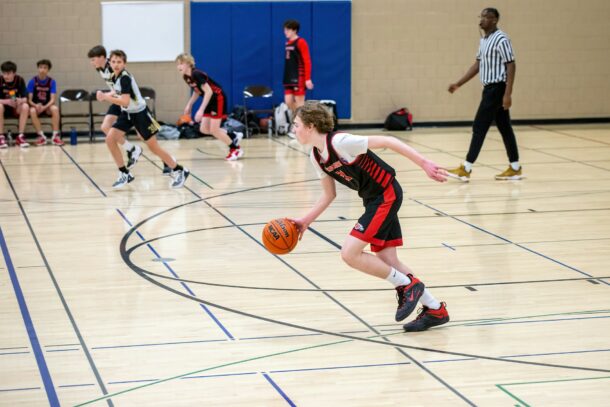When people think of success on the basketball court, they often picture star players making flashy plays. But experienced coaches know the truth: games are often won or lost by the players beyond the starting five. Your bench matters. If you want consistent wins, you need a second unit that understands your system, executes under pressure, and contributes without disrupting chemistry. That starts with intentional, consistent basketball skill development.
In this post, we’ll break down proven ways to develop your bench into a dependable, game-ready unit. Every tip below is rooted in real coaching experiences and built for practical use with youth teams.
Shift the Focus of Basketball Skill Development
Many new or inexperienced coaches rely on static drills, things like stationary ball handling, one-handed passing, or cone zig-zags. These have value, but they don’t teach players how to think. Game performance is about reactions, not routines. So shift your focus toward decision-based drills. Give players scenarios where they must choose and act quickly.
Start with a “catch-and-react” drill. Have a player catch the ball at the short corner or wing. On the catch, give them 1–2 options: attack baseline or middle. Add a defender. Teach them to scan, decide, and go. From there, layer in additional reads: help defense rotation, post feed, or pull-up. Let the drill evolve based on game situations.
By repeating these reactive moments, players stop thinking and start playing instinctively. And that’s when development becomes game-real.
Use Small-Sided Games for Basketball Skill Development
Want your bench to get better? Let them play. But in controlled, competitive, small-sided settings. Small-sided games (2-on-2, 3-on-3, 4-on-4) speed up learning because they isolate key decision-making moments.
In a 5-on-5 setting, a bench player might go minutes without touching the ball. In a 3-on-3 setting, they’re involved constantly.
Add simple rules to shift the focus. Try 3-on-3 where players must pass within 2 seconds. Or 2-on-2 with no dribbles allowed. These rules force quicker thinking and better spacing. You can even run a 4-on-4 “advantage” game: defense starts with only three players, offense reads and attacks the gap.
Keep scores and rotate teams quickly to maintain pace and energy. Bench players thrive in these formats because they learn how to read defenders, use space, and make fast decisions.
Make Rebounding Part of Basketball Skill Development
Rebounding is often treated as a hustle stat. While effort is critical, it’s also a teachable skill. Especially for youth players, learning how to box out and read angles can be the difference between a rebound and a put-back bucket.
Teach “find, hit, get.” That’s your rebounding sequence. First, locate your assignment. Next, initiate contact. Finally, go get the ball. Simple, clear, and actionable.
One effective drill: position two players, one on the wing, one under the hoop. Toss a shot from the top. When the shot goes up, both players sprint to the ball. The one underneath works on boxing out; the wing player works on attacking the glass. Add consequences if the ball hits the floor. This raises intensity without needing to run extra sprints.
Another option: play 5-on-5 where a missed box-out equals a point for the other team. Now your team connects rebounding with winning.
Join the TeachHoops Community

TeachHoops.com offers a unique platform for coaches to share experiences and gain new insights. Learn from others who have navigated similar challenges. It’s an invaluable resource for those looking to:
- Broaden perspectives
- Refine strategies
- Enhance their leadership and motivational skills
Step into Enhanced Coaching
Win the Season: Basketball Masterclass!

On-Ball Defense Is a Must-Have Skill
Bench players won’t always get touches, but they can earn minutes with defense. And nothing gets a coach’s trust faster than strong on-ball pressure. But players must be taught how to defend, not just told to “stay in front.”
Drill footwork and angles in short bursts. Start with a “mirror drill.” Two players face each other: one on offense, one on defense. The offensive player can shuffle left or right, no ball, no fakes. The defender mirrors their movement. Focus on low hips, active hands, and short steps.
Then layer in a live ball. Let the offensive player attack with one dribble max. Defender focuses on forcing weak-hand drives and keeping their hips square. Rotate pairs every 30 seconds to keep energy high.
Don’t forget to emphasize help defense and recoveries too. Bench players often come in cold. They need to be mentally sharp and positionally aware to contribute defensively.
Every Player Should Learn to Shoot
Not every player will become a scorer, but every player should be able to shoot. It’s the most universal skill in basketball, and it travels to every level. Great shooters space the floor, force closeouts, and give your offense breathing room.
Teach consistent form. Repetition matters here. Require every player to make 50 form shots before practice or after. Use a shooting ladder in workouts: start short, move out, track makes. Teach players that shooting under pressure starts with shooting under control.
Here’s a challenge to give your team: in an empty gym, your shooters should hit 60% from three. If they can’t do that without a defender, they’ll struggle when a defender contests or bumps them. Help players understand that gym shooting and game shooting are not the same, but one builds the other.
Build Skill Through Repetition and Accountability
Skill doesn’t develop through variety alone. It develops through repetition, accountability, and purpose. As the coach, set a tone that the bench must meet the same expectations as the starters.
Start with accountability. If no one boxes out in a drill, stop the action. Explain the mistake. Reset. If your second unit turns the ball over, don’t ignore it. Teach the right choice and run it back.
Use a rotation that gives your bench group specific goals during scrimmages. For example: hold the other team to one shot, move the ball through all five players, or force two turnovers before rotating out. This gives structure and lets players connect effort to results.
Even when you’re not drilling specific skills, your culture is always developing. So make sure your bench players know they’re a vital part of it.
Final Thoughts on Basketball Skill Development
The best way to prepare players for games is by mimicking games. That means creating pressure, enforcing decision-making, and building habits they can rely on when things speed up. Your bench needs reps just like your starters. Let them play, make mistakes, and learn in controlled chaos.
When you focus on basketball skill development that builds thinking players, not just skilled ones, you develop a team that’s deep, confident, and ready for any moment.
Latest Posts
- AI Tools for Basketball Coaches: Saving Time and Improving Your Program
- Complete Offseason Basketball Workout for Youth Players
- The Best Youth Basketball Passing Drills Every Coach Should Know
- How to Build a Youth Basketball Defensive System That Works
- How to Make Every Youth Basketball Practice Engaging





